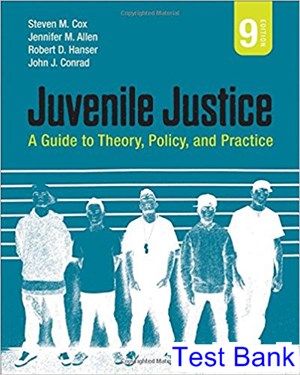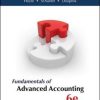Juvenile Justice A Guide to Theory Policy and Practice 9th Edition Cox Test Bank
$35.00 Original price was: $35.00.$26.50Current price is: $26.50.
Juvenile Justice A Guide to Theory Policy and Practice 9th Edition Cox Test Bank
Instant download Juvenile Justice A Guide to Theory Policy and Practice 9th Edition Cox Test Bank pdf docx epub after payment.

Product details:
- ISBN-10 : 1506349005
- ISBN-13 : 978-1506349008
- Author: Steven M. Cox (Author), Jennifer M. Allen (Author), Robert D. Hanser (Author)
Brief, focused, and up-to-date, Juvenile Justice: A Guide to Theory, Policy, and Practice, Ninth Edition, by Steven M. Cox, Jennifer M. Allen, and Robert D. Hanser, is a must-have text that takes students on a journey through the practical realities of the juvenile justice system and the most current topics in the field. Students not only learn about the history, process, and theories of the juvenile justice system, but they also gain access to the latest crime measurements and explore important issues such as community-based sanctions, treatment and rehabilitation, gangs, and international youth crime. Emphasizing evidence-based practices, the authors guide readers through the methods and problems of the system and offer realistic insights for students interested in a career in juvenile justice. Real-life examples, excellent pedagogical features, and a complete online ancillary package are provided to help instructors effectively teach the course and help students learn interactively.
Table of contents:
Preface
Chapter 1. Juvenile Justice in Historical Perspective
What Would You Do?
Juvenile Justice Historically
Continuing Dilemmas in Juvenile Justice
Rethinking Juvenile Justice
Summary
Key Terms
Critical Thinking Questions
Suggested Readings
Chapter 2. Defining and Measuring Offenses by and Against Juveniles
What Would You Do?
Legal Definitions
Changing Definitions
Age Ambiguity
Inaccurate Images of Offenders and Victims
Behavioral Definitions
Official Statistics: Sources and Problems
Official Delinquency Statistics
Official Statistics on Abuse and Neglect
National Crime Victimization Survey
Sources of Error in Official Statistics
Unofficial Sources of Data
Self-Report Studies
Police Observational Studies
Summary
Key Terms
Critical Thinking Questions
Suggested Readings
Chapter 3. Characteristics of Juvenile Offenders
What Would You Do?
Social Factors
Family
Education
Social Class
Gangs
Drugs
Physical Factors
Age
Gender
Race
Summary
Key Terms
Critical Thinking Questions
Suggested Readings
Chapter 4. Theories of Causation
What Would You Do?
Scientific Theory
Some Early Theories
Demonology
Classical Theory
Rational Choice Theory
Deterrence Theory
Routine Activities Theory
The Positivist School
Biological Theories
Cesare Lombroso’s “Born Criminal” Theory
Other Biological Theories
Biosocial/Neurological Theory
Psychological Theories
Sigmund Freud’s Psychoanalytic Approach
Psychopathology
Behaviorism and Learning Theory
Sociological Theories
Anomie and Strain Theory
Ecological/Social Disorganization Approach
Edwin Sutherland’s Differential Association Theory
Labeling Theory
Conflict, Radical, Critical, and Marxist Theories
Feminism
Control Theories
Integrated Theories
Summary
Key Terms
Critical Thinking Questions
Suggested Readings
Chapter 5. Child Abuse and Neglect
What Would You Do?
Child Maltreatment
Physical Abuse
Child Neglect
Emotional Abuse of Children
Sexual Abuse of Children
Internet Exploitation
Intervention
Summary
Key Terms
Critical Thinking Questions
Suggested Readings
Chapter 6. Purpose and Scope of Juvenile Court Acts
What Would You Do?
Purpose
Comparison of Adult Criminal Justice and Juvenile Justice Systems
Protecting the Juvenile From Stigmatization
Maintaining the Family Unit
Preserving Constitutional Rights in Juvenile Court Proceedings
Scope
Age
Delinquent Acts
Unruly Children
Deprived, Neglected, or Dependent Children
Jurisdiction
Concurrent, Exclusive, and Blended Jurisdiction
Waiver
Double Jeopardy
Summary
Key Terms
Critical Thinking Questions
Suggested Readings
Chapter 7. Juvenile Justice Procedures
What Would You Do?
Rights of Juveniles
Bail
Taking Into Custody
Interrogation
Detention Hearing
Detention or Shelter Care
Preliminary Conference
Petition
Notification
Adjudicatory Hearing
Social Background Investigation, Social Summary Report, Presentence Investigation, or Predisposition Investigation
Dispositional Hearing
Summary
Key Terms
Critical Thinking Questions
Suggested Readings
Chapter 8. Juveniles and the Police
What Would You Do?
Police Discretion in Encounters With Juveniles
Unofficial Procedures
Official Procedures
Training and Competence of Juvenile Officers
Police-School Resource Officer and Liaison Programs
Community-Oriented Policing and Juveniles
Police and Juvenile Court
Summary
Key Terms
Critical Thinking Questions
Suggested Readings
Chapter 9. Key Figures in Juvenile Court Proceedings
What Would You Do?
Prosecutor
Defense Counsel
Relationship Between the Prosecutor and Defense Counsel: Adversarial or Cooperative?
Juvenile Court Judge
Juvenile Probation Officer
Children and Family Services Personnel
Court-Appointed Special Advocates
Training and Competence of Juvenile Court Personnel
Summary
Key Terms
Critical Thinking Questions
Suggested Readings
Chapter 10. Prevention and Diversion Programs
What Would You Do?
Prevention
Diversion Programs
Examples of Prevention and Diversion Programs
School Programs
Wilderness Programs
Restorative Justice Programs
Children and Family Services
Federal Programs
Other Diversion and Prevention Programs/Therapeutic Courts
Some Criticisms
Child Abuse and Neglect Prevention Programs
Summary
Key Terms
Critical Thinking Questions
Suggested Readings
Chapter 11. Dispositional Alternatives
What Would You Do?
Probation
Foster Homes
Treatment Centers
Juvenile Corrections
Capital Punishment and Youthful Offenders
Possible Solutions
Summary
Key Terms
Critical Thinking Questions
Suggested Readings
Chapter 12. Violent Juveniles and Gangs
What Would You Do?
Violent Juveniles
Juvenile Homicide and Juvenile Violence
Gangs
Brief History of Gangs
Defining and Identifying Street Gangs
Roles and Activities of Juvenile Versus Adult Gang Members
Gang Affiliation and Identification Along Racial Lines
Delinquent and Criminal Gang Activities
Gang Membership
Characteristics
Age
Gender
Monikers
Graffiti
Jargon
Recruitment
Juvenile Girls and Gang Membership
Response of Justice Network to Gangs
Public, Legislative, and Judicial Reaction
Alternatives to Incarceration for Violent Juveniles
Establishing a Juvenile Gang Exit Program
Summary
Key Terms
Critical Thinking Questions
Suggested Readings
Chapter 13. Global Issues in Juvenile Justice
What Would You Do?
Problems With Delinquency in the Global Community
Characteristics of Juvenile Delinquents Around the World
Juveniles as Victims of Crime
Juvenile Exploitation and Delinquency
Juvenile Exploitation in Underdeveloped and War-Torn Areas
Urbanization and Delinquency in Developed Countries
Age of Responsibility
Delinquency in Various World Regions
Africa
Asia
Latin America
Middle East
Eastern Europe
Juvenile Gangs Around the World
Mexico and Central America
Africa
Asia
Europe
Australia
International Approaches to Preventing Juvenile Gangs
Human Trafficking and Youth Exploitation
International Administration of Juvenile Justice
International Standards and Documents
Use of Restorative Justice With Young Offenders Around the World
Summary
Key Terms
Critical Thinking Questions
Suggested Readings
Chapter 14. The Future of Juvenile Justice
What Would You Do?
Possibilities for the Future of Juvenile Justice
Barriers to Change in Juvenile Justice
Possible Improvements to the Juvenile Justice System
Key Terms
Critical Thinking Questions
Suggested Readings
Appendix
Glossary
References
Index
About the Authors
People also search:
Juvenile Justice A Guide to Theory Policy and Practice 9th Edition
Juvenile Justice A Guide to Theory Policy and Practice 9th Edition pdf
Juvenile Justice A Guide to Theory Policy and Practice
what are the 4 d’s of juvenile justice
is juvenile adjudication a conviction
Related products
Test Bank
Test Bank for Decision Support and Business Intelligence Systems, 9th Edition: Efraim Turban
Test Bank
Test Bank for Essentials of Business Law and the Legal Environment, 11th Edition: Richard A. Mann











